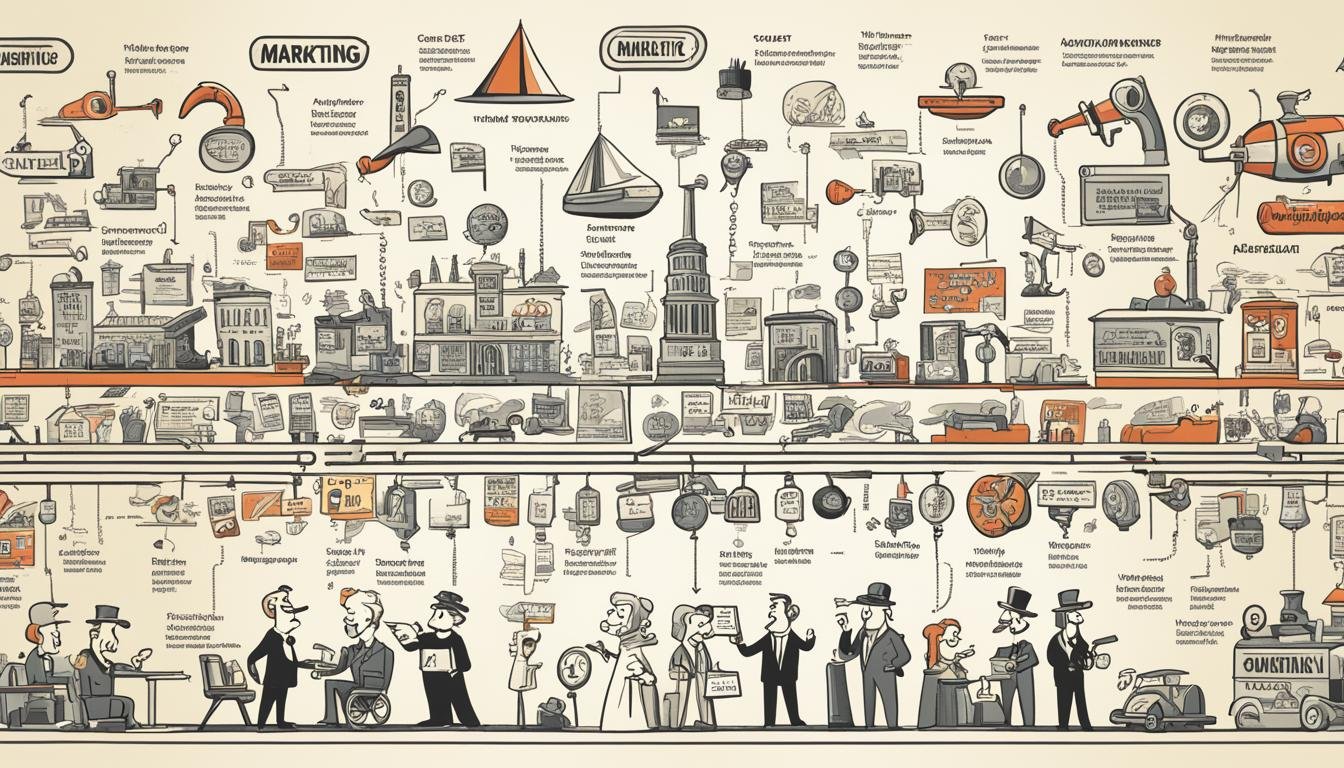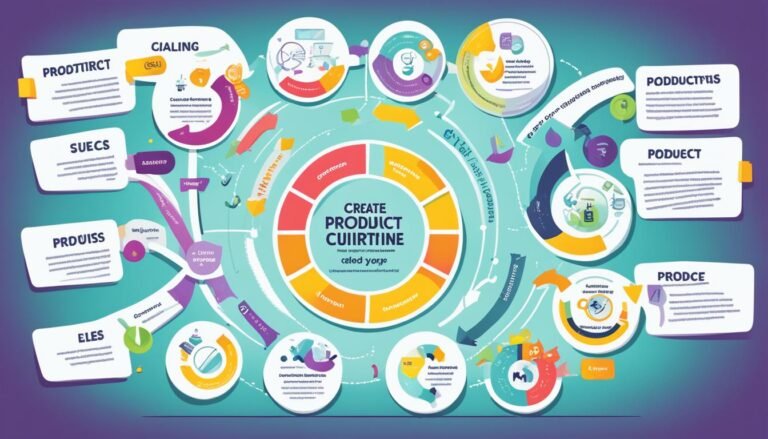The Evolution of Marketing Thought
The word ‘marketing’ first showed up in dictionaries in the 1500s, linked to buying and selling. By the 1900s, marketing had grown into a key field with complex strategies. Knowing how marketing has changed is key, from the post-Civil War era to today’s digital age.
Marketing has moved from focusing on making lots of products to caring about customers and society. This change shows how companies now see and serve customer needs and their social duties. These changes highlight a move from just making things to focusing on customers and doing things right.
Marketing has changed a lot, moving from old production methods to today’s digital strategies. These changes help us understand how consumers act and how markets work. They also show the big challenges and chances businesses face. This knowledge helps marketers make smart, responsible plans that help brands grow and meet what customers want.
Key Takeaways
- Marketing has evolved through different stages, showing changes in what consumers want and what society values.
- At first, marketing was all about making things efficiently and well, then moved to aggressive sales in the middle of the century.
- The marketing concept, which puts customers first, came up because of market overload.
- Societal marketing combines what customers want with what’s good for society in the long run.
- Knowing about marketing’s history is key to making strategies for the future.
Introduction to Marketing: Then and Now
Marketing has changed a lot, from simple bartering to complex strategies using both old and new ways. Knowing about the Marketing Philosophies Progression helps us see how much we’ve grown.
The first print ad was in the 1450s, after the printing press came out. By 1742, Benjamin Franklin’s General Magazine had the first magazine ad. In 1862, direct mail ads started, adding more ways to advertise.
Radio ads became more popular than print ads, and TV ads in 1942 opened new ways for brands to reach people. The first marketing course was offered at the University of Pennsylvania in 1902, showing the need for marketing experts.
The 1950s brought the marketing mix idea, first mentioned in 1952 and made popular in 1964 by Neil Borden. This idea showed how important it is to know about product demand, pricing, promotions, and where to place ads to succeed.
The 1970s brought digital technology, and personal computers arrived in 1975, changing marketing a lot. The early 1990s saw the first search engines, starting a new era in online ads and SEO.
In the 21st century, smartphones and tablets changed how we browse, making marketers look for new ways to connect with people. Digital tools now help understand Consumer Behavior Understanding better, giving a full view of marketing success.
Now, marketers use integrated methods to track their work online and offline. The focus is on keeping customers happy and interacting with the brand, using digital and social media campaigns.
The Production Concept: Birth of Mass Production Marketing
The Production Concept started during the Industrial Revolution, changing marketing forever. This time, from just after the Civil War to the 1920s, saw a big change in making and sharing goods. Goods were no longer made in homes but in big businesses.
Historical Context
The Industrial Revolution pushed Mass Production Marketing forward. To meet growing demand, producers aimed to make more with less cost. They believed that if they made it, people would buy it because it was available and affordable.
This led companies to make a lot of products. The marketing world in the U.S. went through four main eras during this time. These were the production, sales, marketing, and marketing company eras.
The Great Depression was also key during this era. The 1929 economic crash, known as Black Tuesday, made over $30 billion disappear from the U.S. economy. With unemployment at about 25 percent, people had less money to spend, changing how companies promoted products.
Key Features and Impacts
The Production Era focused on making lots of products, cutting costs, and getting products out there. Companies bought a lot of machines and built big places to make things. This era changed how products were sold, focusing on being easy to find and cheap.
This big change affected businesses a lot. It showed the need for efficient making and sharing of products. These changes helped shape how businesses would work in the future.
The Production Concept taught the value of being innovative and flexible in marketing. As companies dealt with making lots of products, they came up with new ways to market. These new methods helped shape future marketing strategies, influencing the industry for many years.
The Product Concept: Focus on Quality and Innovation
The Product Concept in marketing focuses on making high-quality, high-performance, or innovative products. This idea grew from the 1920s to the 1950s. Managers aimed to create better products and keep improving them. Brands like Apple, Bose, Doc Martens, and Tag Heuer show how this works by always offering top-notch goods.
Characteristics and Evolvement
During this time, companies focused a lot on quality, performance, and innovation. This led to better product designs and higher customer expectations. But, chasing perfection was hard. Managers often got too attached to their products, risking the “better-mousetrap” mistake. This is when they focus too much on making products better without seeing what the market really wants.
Marketing Myopia and Its Lessons
Marketing Myopia, a term coined by Theodore Levitt, shows the dangers of the Product Concept. It happens when a company gets too caught up in its product and misses the big picture. This includes market trends and what customers want now.
The lessons from Marketing Myopia teach us to look at the big picture. Companies should make sure their plans match what customers want and how the market is changing. This way, marketers can keep focusing on quality and innovation while also listening to what customers need.
The Sales Concept: Persuasion Takes Center Stage
In the 1950s, markets got crowded and competition grew. This led to the Sales Concept becoming more important. Companies started focusing on persuading people to buy, not just making products.
The Rise of Competitive Strategies
Competitive Marketing Strategies became key in this time. Companies used bold moves to stand out. They focused on prices and new sales methods to win over buyers.
Advertising and Personal Selling
Advertising and personal selling became big for persuading people. Ads in newspapers, radio, and TV made a big impact. Personal selling meant talking directly to customers to make them buy.
The Elaboration Likelihood Model (ELM), developed by Richard Petty and John Cacioppo in the 1980s, introduces two routes to persuasion: the central route and the peripheral route. The central route is employed in high consumer involvement scenarios, whereas the peripheral route is engaged when consumer involvement is low.
Brands like Apple and Doritos use the ELM well. Apple uses both the central and peripheral routes to keep customers loyal and trusting:
- The central route uses detailed info and logical arguments for tech-savvy buyers.
- The peripheral route draws in a wider audience with visuals and famous people.
Doritos runs fun ads that speak to its audience, making it a top snack brand. These ads create excitement and fun, key parts of their strategy.
But, there are still hurdles. Companies must keep up with market changes. They need to really know their audience to make a strong marketing plan. A mix of good ads and personal selling is key to selling well and succeeding in the market.
The Evolution of Marketing Thought
The story of Marketing Theories and Philosophies is fascinating. It shows how marketing has changed over time. It started with the production concept in the 1800s to 1950s. Companies like Ford focused on making things efficiently and cheaply. This led to mass production and affordable products.
Then, the product concept took over from the 1920s to the 1950s. This phase was all about making better products. Companies like General Electric and Procter & Gamble worked hard to improve their products. They often raised prices because their products were better.
The 1950s brought the sales concept. With more competition, companies used strong sales tactics. They created big ads and hired many salespeople. Brands like Coca-Cola used these methods to get noticed and gain more customers.
The 1960s introduced the marketing concept. This changed businesses to focus on what customers wanted. Companies started doing market research and making products that fit what people liked. This led to a smarter way of marketing.
Later, the societal marketing concept came along. It added thinking about the good of society and the environment to marketing.
Kotler & Keller (2016) identified five key marketing concepts: production, product, sales, marketing, and societal marketing.
Learning about the history of Marketing Theories and Philosophies helps us understand today’s complex marketing. Each phase learned from the last, leading to strategies that meet both customer needs and societal goals.
The Marketing Concept: Customer-Centric Approach
The Marketing Concept changed the game by moving from product focus to customer-centric marketing. It put the spotlight on what customers need and want. This shift was key for businesses to stand out by really knowing their customers.
Before, marketing was all about making products efficiently and focusing on quality. But now, customers are at the core of everything a business does.
From Products to Needs
Switching to a needs-based approach changed marketing for the better. By using market research to get to know customers, companies made products that really spoke to people. This made customers happier and more loyal, giving businesses a lasting edge.
A customer-centric marketing strategy means making products and services that fit what customers need. It’s about building strong relationships with customers for the long haul, not just making quick sales.
Relationship Marketing
Relationship marketing grew out of the Marketing Concept. It’s all about building lasting bonds with customers, not just making one-off sales. Companies like Amazon and Starbucks use ongoing engagement and personal touches to keep customers coming back.
With loyalty programs and targeted promotions, relationship marketing builds an emotional link with customers. This creates trust and boosts brand loyalty.
The Societal Marketing Concept: Balancing Consumer and Societal Needs
The Societal Marketing Concept was first talked about in the 1970s by Philip Kotler in a Harvard Business Review article. It’s all about finding a balance between what customers want and what society needs. Today, more companies are adding social responsibility to their plans, making this idea very popular.
Environmental and Social Responsibilities
At the heart of the Societal Marketing Concept is Corporate Social Responsibility (CSR). Companies now aim to make profits and meet consumer and societal needs. They must focus on sustainable practices that help both people and the planet for the long run.
The goals of the Societal Marketing Concept include maintaining long-term customer relationships, improving the company’s image in society, and increasing social well-being.
Social marketing means companies do things that help everyone. By making products that make life better for people and society, brands can grow and be respected.
Long-Term Impact on Marketing Strategies
Societal Marketing has a big impact that goes beyond just making money. It helps build strong customer relationships and matches what people now expect from companies. Companies like Jus Agency show how to do this by offering services that improve performance and support social values.
- Focus on lower quality, satisfying, useful, and desirable products
- Integration of social responsibility into marketing strategies
- Commitment to sustainable business practices
Adding CSR to marketing plans helps companies today and tomorrow. As people become more aware and demanding, companies that follow the Societal Marketing Concept will do well for a long time.
The Rise of Digital Marketing: A New Age of Connectivity
Digital Marketing Emergence has changed how businesses talk to customers. Before, companies used print ads, TV commercials, and mail to reach people. But now, the internet has changed everything.
The internet changed marketing big time. Now, websites and emails are key for talking directly to customers. Companies use ads on the internet, search engine tricks, and more to stand out.
Social media like Facebook changed the game in 2004. By 2017, ads on social media were worth $51.3 billion, a huge jump from before. Social media lets companies reach more people and get them involved.
Content marketing is now a big deal. Pay-per-click ads help companies get more visitors and make sales. Tools like Google Analytics help make smart marketing choices by looking at data.
By 1995, 16 million people were online. By June 2019, that number jumped to 4,536 million, or 58.8% of the world. People now spend about 6 hours and 42 minutes online every day.
Mobile devices have changed everything. By 2021, most e-commerce sales will come from mobiles. Mobile ads went up by 39% in 2017 and are expected to keep growing.
Digital Marketing Emergence has made brands more known and loyal. It’s also cheaper to get new customers and keep them happy. This marks a big change in marketing, bringing us into a new era of connection.
Integrated Marketing Communications: Unified Messaging
Integrated Marketing Communications (IMC) brings together different marketing tools like ads, sales promotions, PR, and direct marketing. This way, all messages are consistent and the brand looks the same everywhere.
“Integrated Marketing Communications involves bringing together a variety of different communication tools to deliver a common message and impact customers’ perceptions and behavior.”
Seven common methods of marketing communication used in IMC are:
- Advertising
- Public Relations (PR)
- Personal Selling
- Sales Promotion
- Direct Marketing
- Digital Marketing
- Guerrilla Marketing
Marketing communication aims to share, compete, and convince by giving clear, accurate, truthful, and useful info. It helps brands stand out, reach specific groups, and build loyalty in tough markets.
Campaigns are key to reaching goals. They use detailed marketing plans, often called IMC plans, to track and carry out these efforts over time. These plans tie together the campaign’s themes.
Companies like Patagonia and Sephora show how well IMC works. Patagonia is known for its green message and activism. Sephora uses unique brand codes in its messages.
Studies say the right mix of marketing channels makes campaigns better. This mix helps build the brand and boost sales. Spending 60% on brand-building and 40% on sales, and using various media, often makes a campaign hit. IMC’s consistency helps keep the brand’s image strong and grows the marketing flywheel, keeping customers coming back.
Market Orientation Shifts: Understanding and Adapting to Consumer Behavior
In today’s fast-paced business world, knowing about Market Orientation Shifts is key to success. Companies that focus on what customers want do better than others. They make sure to keep an eye on what people need and like.
This means they always check out and understand how people act to make their products and plans better.
Consumer Behavior Analysis
Looking closely at how people behave is a big part of market orientation. Studies show that companies that focus on the market do better. They keep more customers, 25% more, and are 40% more likely to make new products that hit it off.
By really getting into what people like and do, companies can make things that fit what their customers want.
Market Research and Insights
Good market research helps make smart choices. A study found that companies that really get the market do way better financially. They also get more good word-of-mouth and people stick with them more.
Doing lots of market research helps spot new trends. This lets companies get ready for changes in what people want. In fact, 70% of companies that focus on the market do better when things change.
To wrap it up, using Consumer Behavior Analysis and Market Research Insights is key for companies to do well today. By understanding Market Orientation Shifts, companies can meet and beat what customers expect. This leads to growth and loyal customers.
Conclusion
The journey through marketing’s phases shows how it has changed over time. It has adapted to new tech, social changes, and how consumers behave. From the early days of making products cheaper, marketing grew into a complex field.
Then, the focus was on making high-quality products with special features. Later, the Sales Orientation phase showed how important ads and promotions were. Quality wasn’t enough to make a business grow.
Next, marketing aimed at building strong customer relationships and meeting social needs. The digital age brought more complexity and connections to marketing. Brands like Apple have kept innovating to meet consumer needs, showing the importance of being adaptable.
Looking back, marketing is both a business and a social force. It started with simple economic ideas and grew into a complex mix of Price, Place, Promotion, and Product. This shows how marketing has always been changing.
As we look to the *future of marketing strategies*, businesses must keep up with new tech and focus on customers. This history helps us understand modern marketing and its role in meeting human needs. Marketing will keep evolving, driven by a focus on adding value in a connected world.
Source Links
- 1.4 Evolution of the Marketing Concept – Principles of Marketing | OpenStax
- Evolution of Marketing Theory – From Production to Marketing Orientation
- History of marketing
- A History Of Marketing: Strategy Through The Ages
- The Evolution of Marketing
- The Evolution of Marketing (Infographic) | Brafton
- Marketing: Historical Perspectives | Encyclopedia.com
- Stages of Marketing Evolution
- The Evolution of Marketing – Triangle Marketing Club
- THE MARKETING CONCEPT
- Marketing 101 – The Five Marketing Concepts – Rock Content
- The Five Marketing Concepts Explained | Avalaunch Media
- Marketing Mix Secrets: Introduction to Elaboration Likelihood Model (ELM) | Adcore Blog
- The Evolution of Marketing as a Conversation
- The Evolution from Pre-Academic Marketing Thought to the New Paradigm of Entrepreneurial Marketing
- Evolution of the Marketing Concept – Principles of Marketing Study Guide 2024 | Fiveable
- Conceptualisations of the Consumer in Marketing Thought
- A Societal Marketing Concept
- Societal marketing concept
- The Evolution of Digital Marketing: From Traditional to Modern Techniques
- How digital marketing evolved over time: A bibliometric analysis on scopus database
- Promotion: Integrated Marketing Communication (IMC)
- What Is IMC? Integrated Marketing Communications Explained
- Understanding Market Orientation and How It Works
- 8.1 The Evolution of Marketing
- Evolution Of Marketing – Then & Now
- The evolution of marketing concepts







